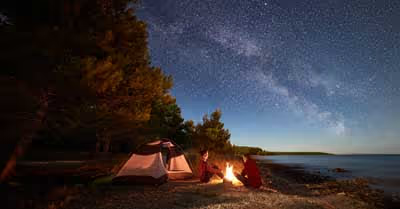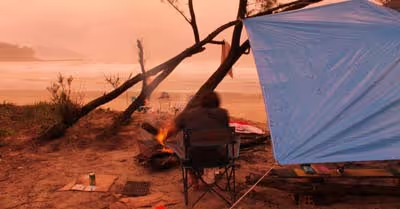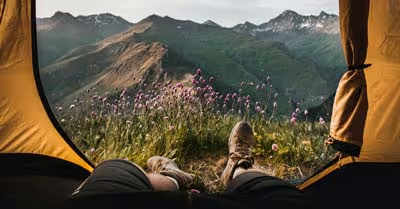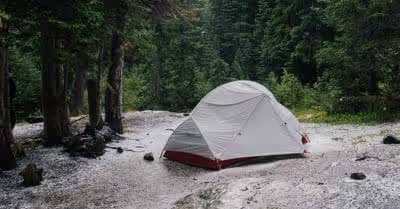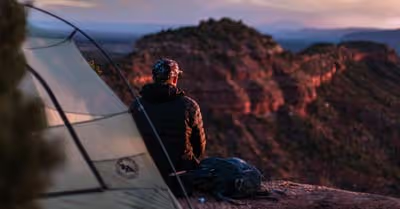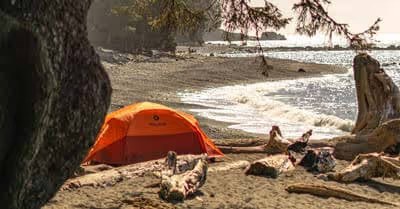Table of Contents
Creating the Perfect Fire Bed
The fire bed is the term used to refer to the area where your fire is going to be built. If you are camping at a designated site with established fireplaces, then you should always choose to build your fire there. If you are camping at a place that will require you to build your own fire bed, there are a few things that you should always keep in mind.
For starters, you'll need to consider the location of your fire bed. You will want the location of your fire to always be far away from any plant materials, be they bushes, trees, or long grass. Of course, this is to ensure that no sporadic flames hop out of your roaring fire onto any dry and flammable materials sitting anywhere around the perimeter.
You'll also want your fire bed to be built directly on the dirt, not on grass or other plant materials. If you are not able to find a perfect spot, you might have to take matters into your own hands and create your own. This can be done by taking a small tool, such as a shovel or small rake, and digging a spot in the dirt just a few inches deep, clearing away any plant matter from the vicinity.
Gathering FireWood, Kindling, and Tinder
Tinder, kindling, and firewood are the names of the three different types of material that you will need in order to start your fire. These are the foods that your fire will feast on in order to grow big and strong. Each material serves a slightly different purpose and will come into play at a slightly different time during the overall process of building your fire. Here's a look at the function of each one:
Tinder (First Material)
Tinder is the name of the material that is used to start your fire initially. Thus, what you use for tinder will need to be exceptionally flammable and easy to light. One common material that is used as tinder is dead plant matter, such as leaves, bark, and grass.
The most important thing to remember is to keep your tinder dry. If your tinder is wet, you won't be able to light it and you'll have to find new tinder. Bringing your own tinder stored from home is an option for those who fear they will have a hard time finding dry tinder in the wild. Some people like to bring dryer lint from home to use as tinder, but others prefer to keep things a bit more natural, especially considering you'll likely be cooking food on your fire.
Kindling (Second Material)
Kindling is the second material that will come into play when creating your fire. It is used to take the flames created from burning the tinder and make them bigger, as well as sustain them temporarily until the fire wood is added. Tinder has a habit of not burning for very long due to it's highly flammable nature, so it is important that you start adding your kindling into the mix as soon as the flame starts overtaking your tinder.
Things that can be used as kindling include various dead branches and twigs that you will likely be able to find many places around your campsite. The pieces you keep shouldn't be very big, as it's typically advised not to use any kindling that is bigger than just about the size of your index finger. As well, it is going to be just as important to make sure your kindling is dry as it is to make sure that your tinder is dry.
Fire Wood (Third Material)
Finally, once the fire has started spreading over from the tinder to your kindling, it's time to add the fire wood. If the tinder is the appetizer and the kindling is the soup, then the fire wood is your fire's main course. This is what your fire will devour over the course of the night, giving it all of the sustenance and energy that it will require.
The drier the fire wood, the better. This is because wet firewood can sometimes take a little bit too long to burn. You should look for dead trees and logs that have very little moisture to them, although a little bit of moisture won't do too much harm.
Also, while you may traditionally envision giant, thick logs when building a fire, the best fire wood is generally not much thicker than the thickest part of your arm. If a log is too thick, your fire might not be able to properly digest it! Keep all this in mind and your fire should have plenty of food to make it through the night, and maybe even some leftover for tomorrow.
Laying Your Fire
Once you've found a nice bed and gathered all of your fire-starting materials, it's time to lay your fire! Laying a fire means creating an arrangement in your fire bed of tinder, kindling, and fire wood. Once arranged, you will light the tinder and a beautiful fire will blossom!
There are almost as many ways to lay a fire as there are days on a calendar, but some methods are more popular than others. While these methods can differ in the specific placement of tinder, kindling, and fire wood, they are usually all fairly similar. For the purposes of this article, we'll take a look at just one of the most simple and effective fire lays, the "Log Cabin Fire Lay".
How to Build a Log Cabin Fire Lay
This type of fire lay is named as such because it resembles a small log cabin that you build in your fire bed and subsequently enflame. Note that you should never actually light a real log cabin on fire. When done right, this is one of the most effective fire lays out there.
You will start out by creating a foundation of four logs in a square within your fire bed, like the four walls of a log cabin. Then, you will take your kindling and create a teepee within these four walls, along with a few extra pieces of kindling crossing the teepee and connecting it to the four walls. Finally, you will add tinder to the base of the teepee and enclose the fixture by finishing off the walls with a couple more pieces of firewood. Once this is complete, light the tinder and watch the fixture go up in flames!
Lighting Your Fire
Of course, when it comes time to actually spark the flame on your tinder, there are many options. Most campers will traditionally bring along a long lighter and some lighter fluid. The lighter fluid can be sprayed (not too generously, mind you) over your fire lay, causing the small flame from your lighter to instantaneously engulf the entire lay.
If you're the type of camper who would prefer to keep things firmly within the realm of more natural means there are no shortage of alternative techniques for lighting a fire. These methods will typically involve using either gathered or stored materials to create a spark using simple friction.
Of course, these DIY methods for lighting a fire are more complicated than simply using a lighter and lighter fluid. While that means that you're going to have to practice them a bit more before mastering them, it also means that mastering them is going to be that much more fulfilling for the aspiring outdoorsmen. Here are some of the most popular DIY methods for lighting a fire:
Hand Drill Technique
The only materials you will need in order to start a fire using the hand drill technique are a few pieces of wood (as well as your tinder, kindling, and fire wood). This technique involves a "spindle", or small wooden stick, and a "fireboard", or the wooden base that your spindle will create friction on in hopes of lighting a spark. Of course, it also involves a lot of physical labor, but that's to be expected.
Essentially, as with most of the other friction-based DIY methods for starting a fire, you just need to create enough friction with the spindle and the fireboard in order for a spark to be created and jump over to the tinder. You will need to make a small notch or indentation on your fireboard that your spindle will then be placed into. Once your spindle is fitted into this groove, you will then begin using your two hands in order to spin the spindle until a spark is created from the friction.
Your spindle should be about two feet in length in order to allow for proper handling. You will need to spin the spindle fast and hard in order to create a spark, and this isn't always going to happen instantaneously. Once the spark is created, there's only limited time to get it over to the tinder and start your fire, so make haste!
Many people will use this set-up in the fire bed itself, that way the spark can instantaneously be dumped into the tinder. However, others choose to carry the spark/ember over to the tinder using a small piece of bark or other medium that can keep the spark alive momentarily during transportation.
Lightly blowing on your spark/ember will help keep it alive when taking it over to the tinder, just don't blow it out or away! As well, blowing lightly on the tinder after the spark has touched it will help the spark overtake the tinder and create a sufficient flame. Then, all you have to do is sit back and watch as the flame devours the tinder, makes it's way over to the kindling, and then starts slowly feasting on the fire wood.
Bow Drill Technique
The bow drill technique is similar to the hand drill technique, except it is slightly easier and a good deal more effective. Because of this, however, you will need a couple more pieces of equipment in order to perform this method. What you'll need, besides your fireboard and spindle, is a bow and a socket.
The bow that you'll create is the same type of bow that makes up a "bow and arrow". Of course, it will be used for a slightly different purpose, and no arrows will be involved. The bow should be about the length of your arm, made from a piece of wood that is slightly flexible, and finished off with any type of string that you have available, wound tightly around both ends.
The socket that you'll need to create can be just about anything, from a small piece of wood to a stone. If you want to use a piece of wood, it will have to be of a stronger type of wood than your spindle. A little bit of sap on the wood won't hurt, either, as it can add to the overall intended friction effect by allowing for a little bit of lubrication between the spindle and the socket.
Once you've created these two pieces, it's time to put this technique to work. You'll place the spindle into the groove on your fireboard just like with the hand drill technique, but this time you'll incorporate both the bow and the socket in order to create the necessary friction that much more easily. Place the socket on top of the spindle, pushing the spindle down into the fireboard with it, and loop the spindle just one single time through the string of your bow.
Finally, saw back and forth with your bow while holding down on the socket, creating an effortless fast spinning motion of the spindle. This fast motion will allow for much stronger and more consistent friction. Of course, stronger and more consistent friction will mean that much more effortless of a spark for you and your fire.
As with the hand drill technique, this spark will need to find it's way to the tinder in order to create the fire. You can use the same set up as you would in that instance, either placing the spindle and fireboard close to your fire lay or using a small piece of bark to carry the spark/ember over once it has been created. If everything goes according to plan, you will have created a nice and simple DIY fire!
Flint and Steel Technique
This isn't a method you are likely going to be able to perform with random materials found around your campsite but, if you have some steel and some flint, it's a fairly simple DIY fire-starting method that everyone should at least be aware of. Flint and steel are commonly sold in survival packs for the purposes of creating fires, and they can also be bought on their own. It's always a good idea to have some flint and steel on hand just in case you need to start an emergency fire.
In order to start a fire using flint and steel, grip the flint between your forefinger and thumb. Then, using the steel, strike the flint in order to create the spark. This should be done in the direction of your tinder, so the spark can effortlessly fly into the tinder and create your fire.
These types of set-ups will also often employ what is known as a "char cloth". This char cloth would serve the same purpose that the small piece of bark did in the hand drill technique and bow drill technique. The char cloth will catch the spark from the flint and steel that you can then throw into the tinder.
If you don't have a steel and flint set on hand, you can create about the same effect just by using a piece of quartzite and the main steel blade of your pocket knife. While it can be a bit tricky to find a rock that will work as well as the flint, this DIY method may prove to be a bit easier than either the hand drill or bow drill techniques for many campers.
Lens Technique
Any demented individual who has ever employed a magnifying glass on an unsuspecting ant hill in their youth has unknowingly employed this technique, just (hopefully) not to the full extent that they started a fire. This technique is based around the fact that a lens has the power to magnify heat from the sun in order to create a fire-starting heat ray. Of course, this method will thus require a good deal of sunlight, which isn't always available when you need it.
Types of lenses that can be utilized in this technique include the ever-popular magnifying glass, but also eyeglass lenses and binoculars. As well, many people don't know that adding just the slightest amount of water to the surface of your lens can help magnify the heat to an even greater degree. Once you've acquired your lens, it's only a single-step process to create your fire, so long as the sun's out.
In order to properly use the lens method, simply set your lens between your tinder and the sun, honing the ray directly into the tinder. The greater the space between the lens and your tinder, the more powerful your heat ray will be. It shouldn't take all that much time before your tinder is up in flames, so long as the sun is shining and producing the proper amount of heat.
Putting Your Fire Out and Making Sure It Stays Out
No matter how proud you are of the fire that you created, the time is always going to come when you're going to have to put it out. Putting out a fire isn't always going to be as easy as it sounds, though. It can be a fairly long process, and you're always going to want to make sure that you do it properly in order to prevent wildfires.
It can often take up to a half an hour before a fire truly dies, so plan ahead and start bringing your fire down to a cool well before it's time to pack it up and head to bed. Most often, fires will be put out using water. It's a good idea to always have a bucket of water by your fire, both for emergencies and for the end of the night when it's time to put the fire out.
While you may feel the desire to empty out your entire bucket of water onto the fire and call it a day, this will ruin the fire bed for good, meaning you won't be able to make any more fires in it for a while. Instead, you're going to want to slowly and steadily sprinkle the water on the fire until the flames are properly suffocated. A smaller container, or even your hands, can be used to easily disperse the right amount of water onto the fire.
Always aim low when sprinkling the water, as the bottom of the fire is what needs to be put out. If you simply aim for the upper flames, the core of the fire will stay alive and will continue to grow. Aim for the center of your fire, towards the embers at the bottom, near where you placed your tinder.
Once you're brought the flames down, you'll want to stir the embers and make sure that they are completely put out, as well. Stirring a little bit more water up in the embers and ashes is also a great way to ensure that everything gets wet so no more fire spreads. Keep stirring and eventually the embers will cool, meaning your fire has totally gone out.
It's usually a good idea to cautiously feel the heat during these last steps in order to ensure that all of the heat has left both the embers and the ashes. Don't touch them directly, but just simply hold your hand about six inches away from them and feel for even the tiniest amount of heat. Until the heat is totally gone, you shouldn't pack it up and head inside.
Recent Articles



